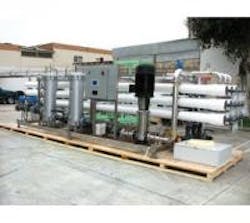Discovered in 2003, the Papa Terra Oil Field is located 68 miles off the coast of Rio de Janeiro in the Atlantic Ocean at a depth of 3,937 ft. It is located in the Campos Basin, which is Brazil’s most important oil-producing region. A joint venture between U.S.-based Chevron Corp. and one of South America’s largest energy companies is operating the field, which has a planned total daily capacity of 140,000 barrels of crude oil.
Key to the oil drilling and production processes is a tension leg wellhead platform (TLWP), which will give the partnership the ability to develop a subsea field with direct vertical access into the well bore. The TLWP includes dry trees, top-tensioned risers and a tender-assist drilling rig, which will support all the well drilling and workover activities, as well as export the production to the floating production, storage and offloading unit.
Such projects present a significant challenge when it comes to the health and safety of platform workers—contractors who are spending long work hours on a jobsite that is far from the mainland need an efficient source of potable water. FloaTEC, the TLWP’s engineering, procurement, construction and installation contractor, selected a combination reverse osmosis (RO) membrane desalination filtration system and ultraviolet (UV) disinfection system to provide potable water to the employees on the TLWP. De Nora Water Technologies provided both systems.
Built to Last
The RO system—a UAT Pure Pro Series seawater desalination membrane filtration system—is designed to treat seawater with 37,000 ppm of total dissolved solids at 25°C. The system has a feed seawater flow rate of 22.4 gal per minute (gpm), a reject flow rate of 16.8 gpm and a product flow rate of 8,064 gal per day. The system—available in a range of output capacities—produces fresh, treated water, which is free of particulate matter or seawater contaminants.
Pure Pro Series systems are easy to operate and built to withstand the harsh offshore and marine environments. They are suitable for commercial, offshore and marine applications, and can be installed in classified areas. They are a cost-effective, easy-to-operate means of consistently providing a source of freshwater—whether for drinking and sanitation, equipment washdown, boiler makeup feedwater, engine cooling or other requirements. The systems are compact, heavy duty and manufactured with corrosion-resistant components, flexible controls and a variety of other standard features. They deliver maximum performance, minimum downtime for service requirements and minimum power requirements.
After the membrane filtration system treats seawater to potable water, it is further treated by a UltraDynamics Series 8102-HIE UV system, which has been proven effective in installations over a broad range of applications around the world over the past two decades. Each UV system provides a dose of 30,000 to 400,000 µW seconds per sq cm at a wavelength of 254 nm UV energy for deactivation of microorganisms.
The UV system utilizes low-pressure germicidal UV lamps positioned in a stainless steel chamber. Pure, fused quartz sleeves used to protect the lamps are manufactured to provide a maximum transmission of UV energy into the medium. The system’s power supply center is rated at 120 VAC, 50/60 Hz and 240 VAC, 50/60 Hz.
Equipment installation was completed in 2012, and commissioning occurred in late 2013.
